The CBR intends to charge the banks for non core assets

With Russian banks having got rid of almost two-thirds of their non-core assets to reach $23 billion, Richard Hainsworth, CEO at RusRating, explained to Business RT the measures the CB is thinking about to speed up the sell off.
RT: The non –core assets at Russian banks are now estimated at around $22 billion. The Central Bank says it could be even more – $66 billion. Do you think that’s a good pace?RH: “The quantity of non – core assets is difficult to asses. The banks don’t have any incentive to keep them on their balance sheet. So, they found various ways of putting these non – core assets into non – core banking subsidiaries. For example, Sberbank has Sberbank Capital, VTB also have another company that takes control over these non – core assets and manages them. Other banks have different ways – they’ve also created securities called as PIFs, which actually package these non – core assets and take them off the balance sheet of the banks. So, just looking at the balance sheet of the bank, which is what is filed with the Central Bank, is actually very difficult to asses how much actually there is in the banking system.”RT: How did the banks accumulate such large amounts of different non – core assets?RH: “One bank has told me that they have a gas station in Murmansk, fishing enterprises on the river Don – a whole variety of enterprises. Some of these enterprises that took loans for themselves and were unable to pay their loans, became the property of the bank. Alternatively, they were borrowers of the bank, who took loans from the bank for some projects of theirs, they couldn’t meet their payments and therefore they lost the collateral they have pledged for repayment.”RT: What about these new rules that the Central Bank wants to implement – namely the requirement to create a special reserve fund for non – core assets, that reaches 75% of the asset price, if it’s on the balance for more than 3 years?RH: “The new rules differ by term and they are still under discussion. Essentially, there’s a problem that faces Russian banks and the Russian Central Bank. The economy at the moment is so week in terms of just going again after the crisis, that there are very many people, who want to offer a very good price for new enterprises – there’s capital available. So, in 2 or 3 years time there will be more capital and these enterprises will worth more to the banks. Therefore, banks want to hold them, so they can send them later. The Russian Central Bank and banking analysts say NO, you should get rid of the assets, generate cash and lend them to new borrowers who can then grow. What is the Central Bank doing is creating penalties for banks if they keep them on their balance sheets. The longer they keep them on the balance sheet, the larger the penalty. So, the Central Bank is trying to force banks to sell these non – core assets. Essentially, the Central Bank is saying if you are going to have a gas station on your balance sheet and you’re not going to sell it, you can’t count that as part of your capital. And if your capital is decreased, you can’t lend as much to the borrowers who want to take big loans. ”














